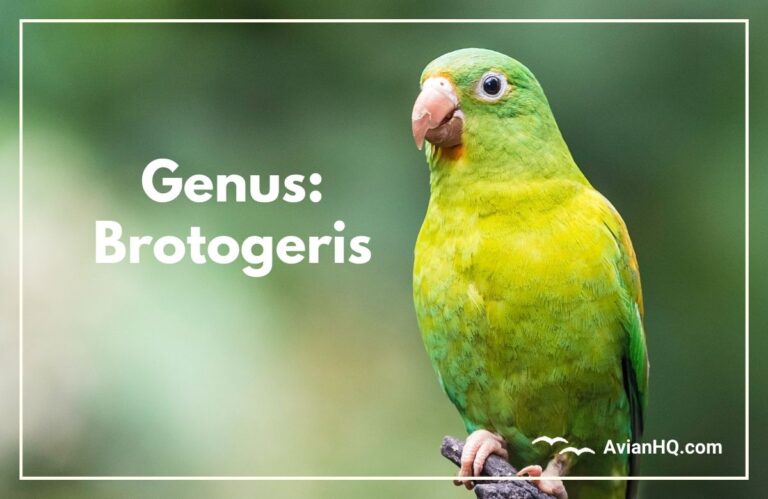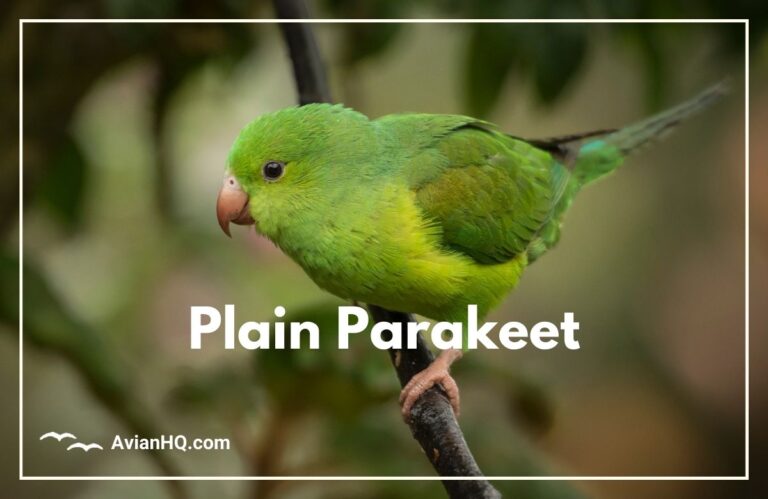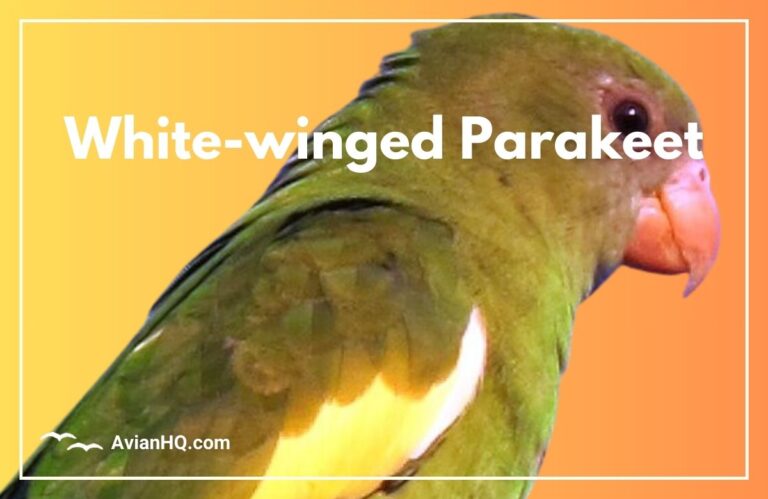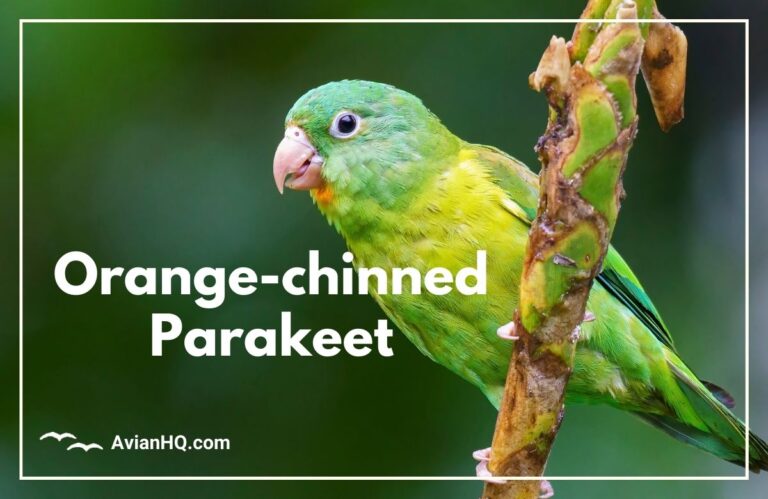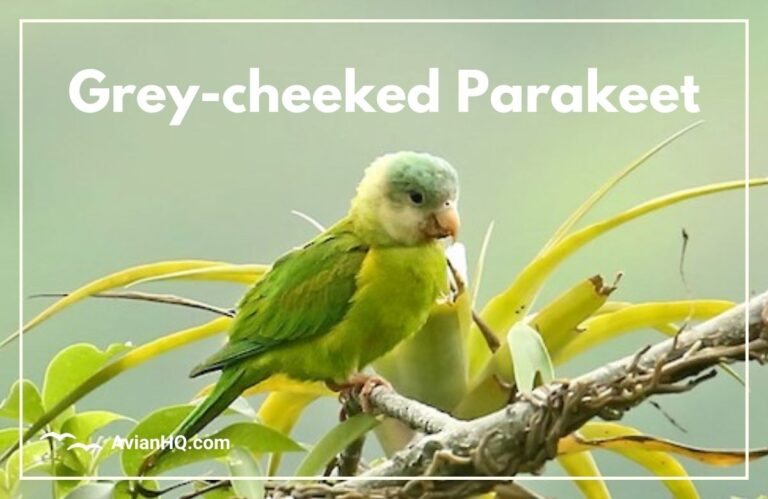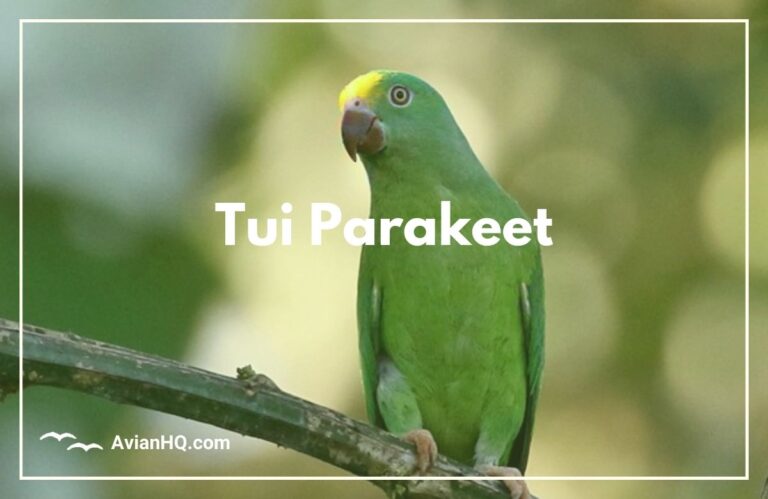Golden-winged Parakeet (Brotogeris chrysoptera)
You catch a glimpse of bright yellow and green feathers swooping through the canopy of the rainforest. A small parrot with striking golden patches on its wings has landed gracefully on a nearby branch. Meet the Golden-winged Parakeet (Brotogeris chrysoptera), a beautiful tropical bird named for its vivid plumage.
Golden-winged Parakeets are endemic to the lush forests of Colombia, Ecuador, Peru, and Brazil in South America. Weighing only 85-125 grams (3-4 ounces) and reaching 20-25 centimeters (8-10 inches) in length, these petite parrots live in flocks that fill the jungle with their squeaking calls. Their bright feathers once made them targets for the caged bird trade, but fortunately their populations remain relatively stable.
“The rainforest explodes with the chatter of these gregarious little parakeets as they flit through the trees foraging on fruit and seeds.”
In this article, you’ll learn all about the Golden-winged Parakeet’s appearance, habits, habitat, unique behaviors, conservation status, and more. You may find yourself charmed by the antics of this tiny parrot of South America’s Amazon as it hunts for figs and berries, seeks tree hollows for nesting sites, and roosts with chattering flocks of its fellow golden-winged companions.
History and Taxonomy
The Golden-winged Parakeet has had a convoluted taxonomical history since its discovery by early ornithologists. Scientifically described for the first time in 1758, it has gone through several name changes over the centuries.
First Discovery
The first formal description of the Golden-winged Parakeet came from the German naturalist Carl Linnaeus in 1758. Linnaeus named the small green parrot Psittacus chrysopterus in his pivotal taxonomy textbook Systema Naturae, basing the scientific name on the Greek words for “gold” and “wing.” For over 130 years, the Golden-winged Parakeet remained classified under Linnaeus’ broad genus category Psittacus.
Scientific Classification
It wasn’t until the 1890s that more specific parrot taxonomy started to develop. In 1897, the species was reclassified into the new genus Brotogeris – a grouping designated for the small, stocky parakeets of South America. Since then, Brotogeris chrysoptera has remained the accepted scientific name for the bird.
Scientific Name Meaning
The genus name Brotogeris comes from the Greek words brotos meaning “eaten” and geranos meaning “crane”. This odd name refers to ancient beliefs that parrots would eat the eggs and newborn chicks of large birds like cranes.
The second part of the species’ name, chrysoptera, derives from the Greek “khrysos” for gold and “pteron” meaning wing or feather. So translated literally, Brotogeris chrysoptera identifies the bird as the “small gold-winged parrot.”
Subspecies and Distributions
Experts currently recognize two distinct subspecies based on physical and geographic differences:
- B. c. chrysoptera – Colombia and northwestern Ecuador
- B. c. tuipara – southeastern Ecuador to northeastern Peru and western Brazil
These subspecies vary slightly in their plumage and occupy mutually exclusive ranges in northwest South America divided by the Andes mountain range. More research is still needed to confirm consistent distinctions between the two groupings.
Physical Appearance
The Golden-winged Parakeet is a small-to-medium sized parrot measuring about 8-10 inches (20-25 cm) long. Their green plumage with vibrant yellow wing patches gives rise to their common name.
Size and Weight
These compact parrots reach a body length of 8-10 inches (20-25 cm) and weigh between 3-4 ounces (85-125 grams). Females tend to be slightly smaller and lighter on average than males. As with most parrot species, the Golden-winged Parakeet’s curved bill adds extra length to its petite frame.
Plumage Colors and Markings
Green is the dominant shade covering the Golden-winged Parakeet’s back, chest, wings, and tail. But its namesake golden-yellow wing patch is by far its most distinct feature. This vibrant splash of color spans the bird’s shoulders down through the front edge of its wings.
The wing patch graduates from a bright yellow to a paler yellow-white closer to the body. A bold yellow stripe also runs along the underside of the wings. The long tail displays yellow tips on otherwise green feathers. The head and cheeks are primarily green with a faint grayish tint. Dark black beaks and greyish legs provide contrast.
Differences Between Subspecies
The two recognized subspecies show subtle variances in color distribution:
- B. c. chrysoptera – Less overall yellow on wings, more extensive green
- B. c. tuipara – Brighter and more extensive yellow areas on wings
Bill, Eyes, Legs and Feet
Golden-winged Parakeets have a horn-colored beak typical of seed-eating parrots. Their sturdy bill easily cracks hard nuts and fruits. Eyes are dark brown encircled by a narrow whitish eye-ring of small feathers. Legs and zygodactyl feet are thick and grayish in color for gripping and climbing.
Habitat and Distribution
Golden-winged Parakeets thrive in tropical lowland rainforests. Their native range covers several South American countries. Small introduced populations also exist in Puerto Rico, Hawaii, and Florida.
Native Range and Habitat
The species is endemic to humid rainforest regions of:
- Colombia
- Ecuador
- Peru
- Brazil
They occupy a strip of the Amazon basin at elevations up to 3,000 feet (915 meters). Their habitat consists of primary and secondary rainforests, forest edges, woodland savannas, and plantations. Golden-winged parakeets preferentially stick to lowland areas but may move up into foothill forests.
Dense, mature stands of tall trees provide their best nesting and foraging grounds. They tend to avoid heavily degraded forests. A diversity of fruit and nut trees to feed on are critical habitat components.
Introduced Populations
Thanks to escaped pets, small introduced populations have taken up residence in areas outside their native range:
- Puerto Rico – Established and breeding in the Rio Abajo Forest
- Hawaiian Islands – Mostly sighted on the Big Island and Maui
- Florida – Spotted in multiple counties but likely not sustaining populations
Elevation Range
In their native South American habitat, Golden-winged Parakeets are considered lowland species. They predominantly inhabit warmer tropical regions at elevations up to 3,000 feet (915 meters). Some seasonal migration upslope into cooler foothill forests occurs when lowland areas get excessively hot.
Diet and Feeding
Golden-winged Parakeets are opportunistic, flexible eaters. They forage widely on a variety of fruits, nuts, seeds, berries, and occasionally insects. Their strong beaks allow them to access protected foods.
Overview of Diet in the Wild
As with most parrots, the bulk of the Golden-winged Parakeet’s diet comes from plant matter. They eat a diverse mix of fruits, vegetables, nuts, berries, seeds, and flowers from rainforest trees and vines. Figs, palm fruits, and Cecropia seed pods are favored foods. Smaller amounts of protein from insects and insect larvae supplement their nutrition.
They exhibit some seasonal differences in diet, targeting specific food resources as they become seasonally available. But overall their feeding habits remain more generalized than other parrot species with specialized diets.
Types of Foods Consumed
Specific food items eaten by wild Golden-winged Parakeets include:
- Fruits – figs, bananas, berries, palms
- Seeds – from seed pods, nuts, flowers
- Vegetation – buds, leaves, bromeliads
- Protein – insects, larvae, eggs
Feeding Behaviors
Golden-winged Parakeets use their curved beaks adeptly to unlock well-protected food sources. Their strong jaws make easy work of cracking Palm nuts and hard-rinded fruits other birds can’t access. Mostly they feed high in rainforest canopies, climbing along branches. But will also forage at lower levels when resources are scarce. They eat almost continuously throughout the day in their high-energy existence.
Breeding and Reproduction
Golden-winged Parakeets reach breeding maturity by 18-24 months old. They nest in tree cavities, laying small clutches of eggs that hatch after 3-4 weeks of incubation.
Nesting Sites
Mated pairs roost in tree hollows, both natural cavities and old woodpecker holes. They exhibit strong site fidelity, reusing nest sites year after year. Nest height ranges from around 16-65 ft (5-20 m) above ground. The female scrapes away wood splinters from the base of the hollow to form the nest.
Clutch Size
Typical clutch size is 3-4 white eggs. The female incubates and broods the eggs while the male provides food. Some cooperative breeding may occur involving additional adults aiding the mated pair.
Incubation and Fledging
Incubation lasts 23-26 days before the helpless, featherless chicks hatch. Chicks fledge at around 8 weeks old but remain closely bonded as a family group for an extended juvenile period of 4-6 months. This allows the fledglings to learn essential life skills like foraging, flocking, and predator avoidance.
Behavior and Ecology
Golden-winged Parakeets exhibit highly social behaviors. They live in noisy flocks that roost communally and forage together for safety. Their climbing skills give them flexibility across forest levels.
Flock Sizes
Golden-wings congregate in large, gregarious flocks of 10-30 birds on average. Groups may reach up to 50-100 individuals at prime food sources. Flocks are composed of extended family units, juveniles, and non-breeding adults. The flock provides critical social bonds and anti-predator benefits.
Roosting Patterns
They sleep huddled together in a chosen roost cavity, lining the hollow with leaves and twigs. Many birds pile into a tight mass to conserve heat in colder months. Flocks continue using the same traditional roost sites for many years.
Foraging and Feeding Behaviors
The birds leave their roost as a flock at dawn to begin feeding. Loud squeaks and squawks maintain contact. They spend almost all daylight hours foraging, moving together through their home ranges. Their strong beaks and feet allow them to exploit food resources across all forest levels.
Interactions with Other Species
Golden-wings integrate well into multi-species flocks of Amazon birds. Mixed flocks provide better vigilance against predators like hawks and snakes. They may compete with other arboreal birds and parrots for limited nesting sites and food resources. But generally coexist peacefully within the diverse rainforest ecosystem.
Conservation Status
While still relatively common across their native range, Golden-winged Parakeet populations have declined from habitat loss and trapping for the pet trade. However, their ability to utilize degraded forests helps buffer habitat impacts.
IUCN Status
The IUCN Red List categorizes the Golden-winged Parakeet as a species of Least Concern. Although habitat loss and capture rates are ongoing threats, populations still appear sufficiently large and stable to avoid threatened status.
Population Estimates and Trends
Comprehensive surveys are lacking to precisely quantify Golden-winged Parakeets’ total world population. Best estimates based on regional densities approach several hundred thousand remaining individuals. But most assessment data points to gradual declines over the last few decades, primarily from accelerating deforestation.
Major Threats
The primary threats to Golden-winged Parakeet survival include:
- Accelerating deforestation of lowland tropical rainforest
- Live capture for the wild bird pet trade
- Persecution as agricultural pests (crop damage)
- Vulnerability to avian diseases
Conservation Protection Efforts
Golden-winged Parakeets receive no formal legal protections or regulated trade limitations. A few reserves protect intact sections of their native habitat. But more habitat conservation plans focused specifically on this species may prove warranted given ongoing declines from land use changes.
Cultural Significance
The Golden-winged Parakeet’s beautiful colors and curious, endearing nature have inspired both scientific and popular interest. Locally they are kept as pets. More broadly they symbolize rainforest conservation.
Local Pet Trade History
Golden-wings’ innate curiosity and desire for social bonds make them delightful pets. Rural tribes have traditionally kept tame golden-wings. Their relative abundance near indigenous settlements facilitated local capture and domestication.
Today the species remains popular in the regional pet trade. Trappers supply local bird markets despite lack of oversight into sustainability. International commercial trade is prohibited.
Symbol of Rainforest Biodiversity
Vibrant green set against shining yellow wings allows the Golden-winged Parakeet to literally embody lush rainforest life. As flagship icons for their diminishing habitat, the species elicits public interest in protecting tropical ecosystems.
Ecotourists flock to remote forest reserves for a chance to spot these charismatic birds first-hand. Their visibility promotes funding for conservation initiatives aimed at habitat preservation.
Conclusion
The Golden-winged Parakeet remains a abundant fixture of South America’s lowland rainforests, from the Amazon basin to the Andean foothills. These gregarious, squeaking birds enliven the canopy with gold-accented wings standing out against green plumage.
While still Least Concern conservationally, the species merits monitoring and habitat protection efforts. Continuing forest loss and live trade capture drive declines in many regions. Protected reserves that conserve mature, biodiverse forest blocks offer the best refuge.
As engaging ambassadors for their imperiled rainforest homes, Golden-wings both suffer from and symbolize the threats facing tropical ecosystems. If conserved effectively, future generations will continue enjoying sightings of these yellow-winged, green-feathered parakeets chattering their way through rainforest treetops.


